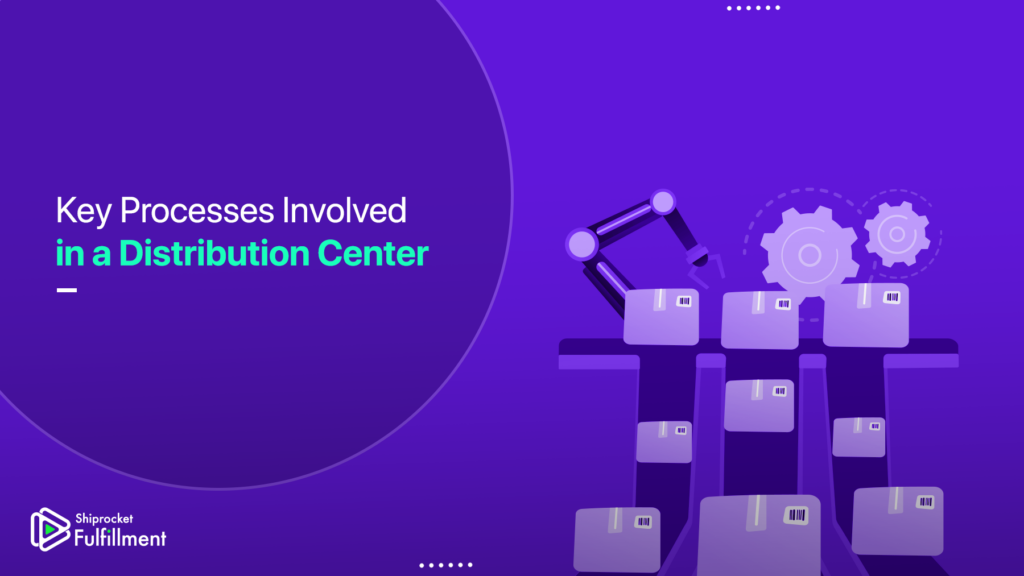Distribution centers are indispensable for eCommerce. They are strategically located to help improve shipping and delivery times. A significant reason for the surge in the popularity of online shopping is the availability of well-planned distribution centers.
What is Distribution Center?
As the name suggests, “distribution centers” are the centers for distribution wherein goods can be safely stored before being delivered to buyers. The buyers can be wholesalers, retailers, or individuals.

With the global e-commerce market expected to achieve USD 58.74 trillion by 2028, distribution centers will continue to be the driving force in accelerating order deliveries and enhancing company revenue. Strategic locations of distribution centers and technology adoption will play crucial roles in streamlining the distribution network of any eCommerce company.
Difference Between Distribution Centres and Warehouses
Warehouses are large spaces that store bulk quantities of goods or e-commerce inventory. They typically store goods for long periods. Warehouses rarely handle order processing and fulfillment tasks. Meanwhile, distribution centers are storage areas equipped with fulfillment infrastructure and technology that help eCommerce companies offer customers affordable, accurate, and prompt shipping.
A distribution center can be called a specialised warehouse that functions as a hub to store finished goods strategically, streamline the picking and packing processes, and transport goods to another location or the final destination. Distribution centers handle order fulfillment and other value-added services.
Though distribution centers and warehouses tend to take on warehousing capabilities such as goods storage, differences exist between the two, each facility designed to handle different operations.
Online retailers and eCommerce companies mostly use distribution centers. They are more agile and focus less on long-term storage and more on the flow of goods. This calls for technology that automatically places orders to the closest distribution center where inventory is stored, thus speeding the fulfillment speed while keeping costs down.

Role of Distribution Centers
With the explosive increase in eCommerce likely to reach $5,288.5 million by 2027, the logistics industry is expected to match demand with automation technology and the strategic location of distribution centers. Competitively-priced service providers like Shiprocket, India’s #1 e-commerce shipping solution are expected to lead the expansion of the industry.
Distribution centers can be operated and managed as per business needs. They are akin to all-in-one logistics operation centers that can store, move, pack, and ship goods to fulfil customer orders. Distribution centers focus on the quick turnover time of despatching finished products to the customer, prioritizing improved speed at lower costs.
The management of distribution centers combines traditional warehouse best practices, such as inventory management, space optimization, and quality control, with fulfillment practices, such as order processing, product return, and exchange processes.
Distribution centers form the elementary units of supply chain networks. They can run more efficiently by adopting the right technology, from warehouse automation technology to enterprise resource planning (ERP) solutions.
Key Processes Involved in a Distribution Center

A distribution center’s processes are designed to process orders quickly by picking, packing, and transporting packages to customers cost-effectively. It involves real-time monitoring of inventory levels to keep operations running as efficiently as possible.
Some significant processes involved at distribution centers are:
Receiving of goods
Receiving goods involves delivering, unloading, inspecting, and adequately storing goods at the distribution center. This process also involves proper documentation to avoid issues later on. Quantity and quality checks are conducted to ensure the goods are correctly received.
Storage of goods
Once the goods are received, they are stored in the distribution center for further processing. Goods are stored depending on the inventory management strategy used by the center, such as First In First Out (FIFO), Last In First Out (LIFO), or Last In Last Out (LILO). Proper handling and storage of sensitive or temperature-controlled products must be prioritized to prevent loss or damage to the product.
Order fulfillment
After an order is received from a customer, the goods are segregated (picked), packed, and then shipped to the customer’s correct address. With the help of technology, one can automatically assign similar orders with inventory near the warehouse, thus reducing delivery steps. This also creates an efficient workflow and improves speed and order accuracy.
Returns management
A returns management process can significantly improve a company’s bottom line. Distribution centers that process returns must coordinate with customers to initiate the return and, once the product is received, restock or refurbish it.
Streamlining of Distribution Networks with the Best Distribution Centres
Distribution networks are interconnected storage facilities and transportation systems that receive goods and deliver them to customers. For a supply chain to function efficiently, ensuring that the distribution network is streamlined with the best type of distribution centers is of utmost importance. Distribution centers function as traditional-type warehouses but also have the capabilities of fulfillment centers to quickly and easily deliver goods to customers. Instead of reordering goods and waiting for delivery, retailers can easily collect them from the nearest distribution centers for hassle-free delivery to end-users.
Distribution centers help improve distribution efficiency and promote business growth when correctly aligned. Inventory-carrying costs can be reduced through the use of good distribution centers. If a distribution network has multiple well-aligned distribution centers, the efficacy of delivering goods to consumers can significantly improve. Examples of companies having multiple distribution centers are Amazon and Nike.
Care needs to be taken while operating distribution centers. Errors during the pickup and packing stages can lead to wrong deliveries, stoking customer discontent. Besides time being wasted, additional funds will be needed to replace the goods. Quality control needs to be maintained; else, it can lead to a reputation downgrade in the market. Shiprocket enables businesses to achieve 3x faster deliveries by storing inventory closest to customers in a pan-India network of e-commerce fulfillment centers.
Conclusion
Distribution centers are a vital part of the distribution network in logistics. They play an important role in ensuring finished goods are available to the customer in the shortest time and lowest cost possible. Distribution centers receive goods, store them properly, and pick, pack, and ship when an order is received. The distribution network will eventually be able to ensure order fulfillment. Automated systems help to easily track and trace goods with less human intervention and reduced paperwork.
Considering the critical need for distribution centers, organisations that were earlier investing in their own facilities are now exploring third-party service providers to sustain the explosive growth of eCommerce sales. Streamlining the distribution network with the best type of distribution center is essential to ensure the supply chain functions at its optimal best.

Frequently Asked Questions(FAQs)
A distribution network ensures the organisation has a properly functioning supply chain. The distribution center plays a vital role in the distribution network. It helps to ensure the finished goods are readily available in the shortest time and lowest price to the customer. Strategic distribution centers will ensure that the distribution network is robust and can help the organisation ensure fast customer delivery.
There are primarily three processes in a distribution center. The first is the receipt of goods. Goods are received in the center and checked for quantity and quality. The second process is properly storing goods for easy tracking and tracing. Quick retrieval of goods is of prime importance. The third process is order fulfillment, which requires the correct quantity and product to be packed and shipped to a valid address at the earliest.
Some commonly used automation mechanisms are RFID systems that can automatically track the position of the goods in the distribution center, and automatic storage and retrieval systems, which help store and retrieve goods with ease and less human intervention. These include vertical lifts, cranes, and robotics. Using automatically guided vehicles to receive goods and deliver them to the exit station at the distribution center is very helpful as they free up a workforce who would otherwise be occupied with executing repetitive tasks.





